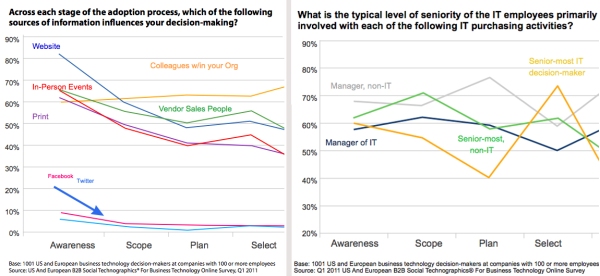A persona is an internal model of the key attributes, motivations, and goals of your target customers (prospect, audience…). A persona is a statement from you to your customers and prospective customers that illustrates to them, that you understand their jobs-to-be-done, their needs, as well as, what keeps them up at night (the emotional component). It should be used to describe your customers to your internal teams, from Engineering to Finance – and all in between – making sure everyone understands it.
A business exists to provide value to, for and with customer’s. They do not exist to promote products; sorry. In a business to business (BtoB) setting, the ‘to, for and with’ is not likely restricted to one person or role on either side of the equation. From the customer side, the buying process includes a set of people who, at the end of the day, are trying to understand, “what’s in it for me”. Therefore, there is likely more than one persona who needs to be heard, considered and the more complex the product, the more personas in the mix.
Who considers What, and When?
I spent the past few days thinking more about the execution parts of marketing more than I have in quite some time. I kept coming back to personas – and how much sense they make. I could not get the figures below out of my mind. One chart shows which roles (persona) influence which part of the buying cycle, the second chart maps roles (persona) against information source. According to Forrester (source of chart data) “No one influencer has more than 30% of the total power through the purchase process.” and 7.6 is the “Average number of different sources used throughout the purchase funnel.” I do have some issues with broad brush statistics, especially in this case, as the part of the buying cycle does have an impact – as the charts clearly. My interest is in ‘connecting the dots‘ because in isolation, the data is not all the interesting – but together they say something.
The intersection of the two tells a marketer not only where to day something at a certain stage, but who they are talking to, right? If these questions were in the same survey then I would certainly cross tab the results of the two questions. For example it is nice to know that 70% of organizations answered that a manager, not in IT is involved during the awareness phase. It is also nice to know website and In-person are the most influential channels during the awareness phase (Hmm, Hubspot might tell you different). Putting the two together, if logic holds, my website better speak to the persona of a non-IT manger type, no?
Now, I might be trying too hard to connect things that could get you all in trouble if the focus is too strong. I am not suggesting that you ignore the individual contributor, nor the social channels (both lower for the respective questions, during the awareness phase) – but it does give you pause and possibly get you to think about specific messaging. I am not saying to message for the sake of message. I am saying that understanding the perspective of your buyer, speaking to him or her as a human, in language they they understand (aka, not three letter acronyms which makes sense to you).
What about the selection phase? This phase is interesting, as the data suggests that it is the most senior IT person who has the greatest influence and their greatest influence….internal, not external. The buying decision is heavily influenced by “colleagues within the organization”. Now, it is probably not a big leap to suggest that the colleagues are going to share what they have learned during earlier phases. Further, the CIO is not likely the one reading your website, his or her team are the ones reading the website.
Do the charts above speak to you? If so, what do they say? BTW, where does the ‘Passion’ fit in? If you really believe that you can solve specific problems for specific people, then your passion will come through – that simple.
This post was written as part of the IBM for Midsize Business program, which provides midsize businesses with the tools, expertise and solutions they need to become engines of a smarter planet.




